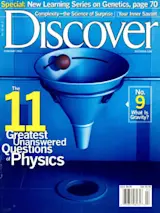Sea Treasure
Pearls, rare and lustrous, reveal their underwater secrets
By Louis Porter
Pearls
American Museum of Natural History
Pearls: A Natural History, Companion Volume Abrams, $49.50
The Biwa pearl mussel from Lake Biwa, in Japan, was once a rich source of cultured pearls until pollution nearly drove the mussels to extinction in the 1990s. Photograph courtesy of Jackie Beckett/American Museum of Natural History
The Swedish naturalist Carl von Linné (better known as Linnaeus) is famed for creating a uniform system for defining and naming the genera and species of organisms. But he earned the Swedish noble title von for a more obscure achievement. In the 1750s, Linnaeus became the first person to culture round pearls artificially. The simple method he devised involved cracking open a freshwater mussel and inserting a bead nucleus, which he then suspended from the surface of the shell with silver wire.
Pearls, a new exhibition ...














